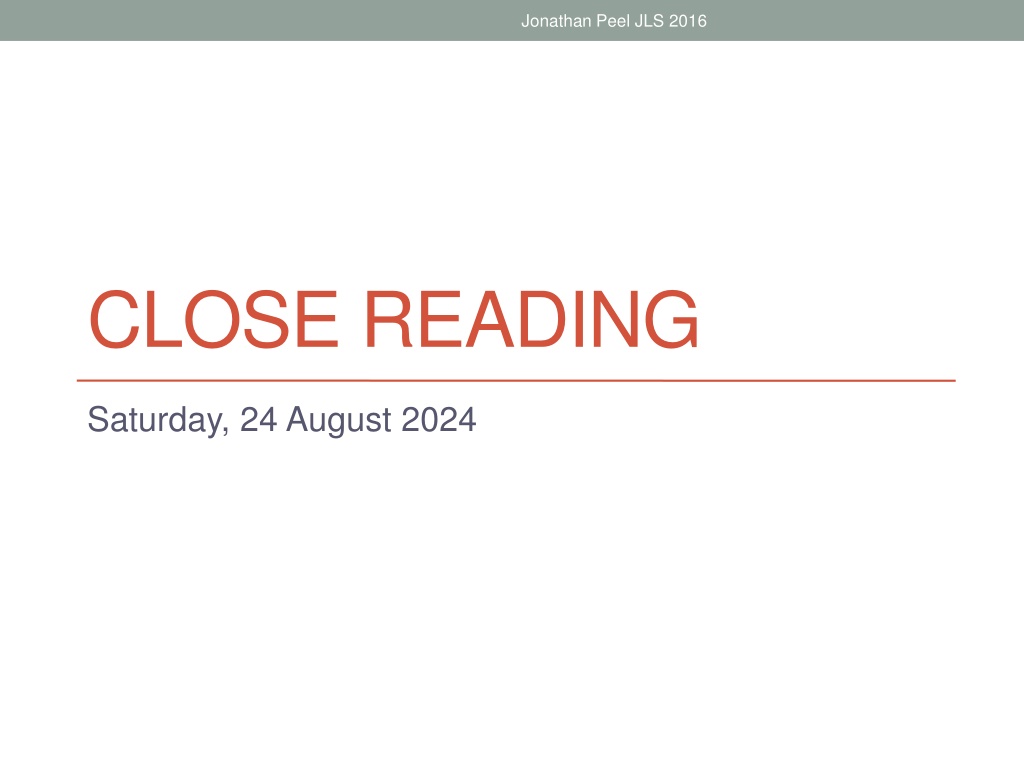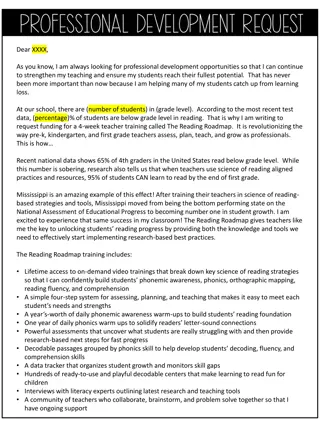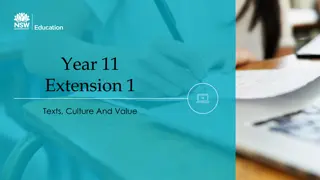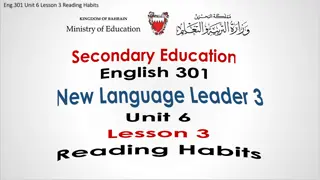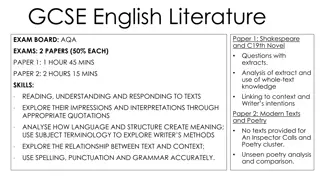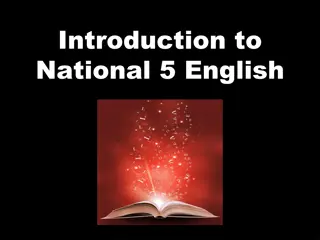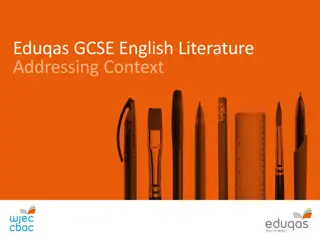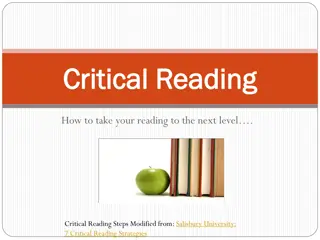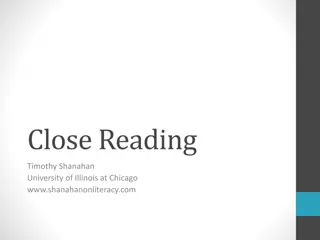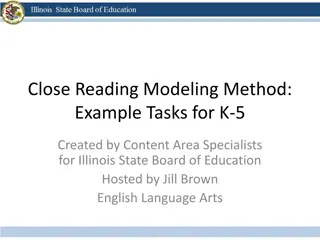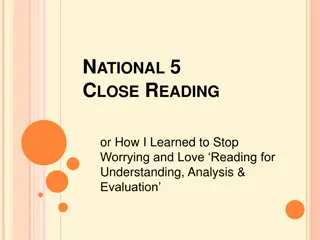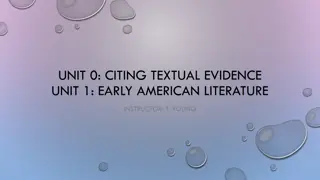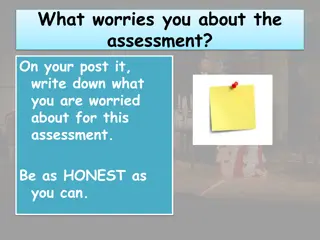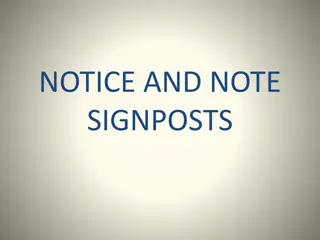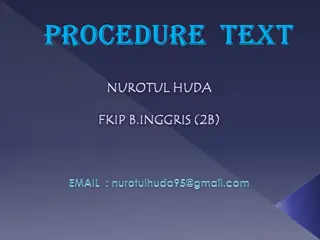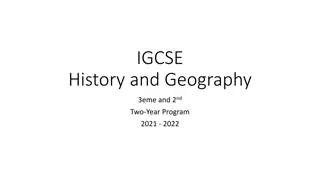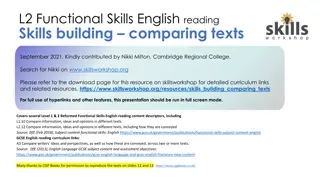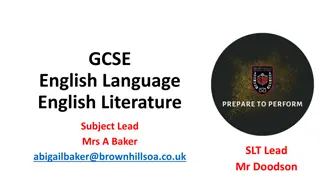Understanding Close Reading in Literature - A Guide to Analyzing Texts Effectively
Dive into the world of close reading with a focus on Jonathan Peel's JLS 2016 coursework task. Learn how to approach passages, ask text-dependent questions, and paraphrase effectively to uncover deeper meanings. Explore the nuances of language and figurative elements to enhance your analysis skills.
Download Presentation

Please find below an Image/Link to download the presentation.
The content on the website is provided AS IS for your information and personal use only. It may not be sold, licensed, or shared on other websites without obtaining consent from the author. Download presentation by click this link. If you encounter any issues during the download, it is possible that the publisher has removed the file from their server.
E N D
Presentation Transcript
Jonathan Peel JLS 2016 CLOSE READING Saturday, 24 August 2024
Jonathan Peel JLS 2016 Your Coursework Task requirements Candidates are required to produce a folder of coursework of around 3000 words with two tasks. Task 1: Close reading (OR re-creative writing with commentary) Candidates can select to do: Either a close, critical analysis of a section of their chosen text or poem. Candidates are recommended to select a small section of text, three to four pages of prose or drama or up to 45 lines of poetry.
Jonathan Peel JLS 2016 What is close reading? From Reading reconsidered by Doug Lemov et al:
Jonathan Peel JLS 2016 Approaching your passage Reading the passage two or three times, always with a notepad and pen. Noting points of interest Remember to look for the deliberate variation of form or the language chosen for impact Jerusalem is a play, so enlist your colleagues and read the passage out loud. Trust your hearing as well as your sight!
Jonathan Peel JLS 2016 Meaning: Text Dependent Questions An overview or gist is not enough for this task When there is a longer speech in the section, try paraphrasing it as a starting point. Paraphrase is not the same as summary. It is a rewriting of the speech in the same person stating the same material in simpler and clarified terms Consider what is lost in the text and you have a starting point when discussing the character or scene in question.
Jonathan Peel JLS 2016 Paraphrase Ok chaps, friends (most of you) and outsiders. Welcome to a meagre meal. Today is a day to draw a line in the sand and to stand up against the council jobsworths all. As leader of the gang, I , Rooster Byron, have a present for you all: free alcohol and drugs. (Cheers) Before I begin, a quick word about one who is leaving us. He s local and belongs here; he s lived here for nearly 20 years and is flying to Australia tomorrow. (cheers) We know he will find it hard to make ends meet and may have to debase himself with the locals, we wish him luck. Lee Piper: drinker, druggie and penny-pincher. But I d trust you with anything, unlike most of these guys. Here s your send off . Tanya?
Jonathan Peel JLS 2016 Response We note the richness of Johnny s language in general Consider his use of the figurative How has this man become such a wonderful orator? How does his language create a sense of grandeur for the occasion and for the group as a whole?
Jonathan Peel JLS 2016 Text Dependent Questions (Word and Phrase level) Require precise focus on the effect created by specific words and phrases... Text Friends! Outcasts, leeches. Undesirables Effect (Think about the punctuation and the specific word choice why does Johnny invoke the ideas of wider society when greeting the group) (why not a line in the sand the more usual metaphor?) Line in the chalk Bastard, pitiless, busybody council Merciless ruler And so on!
Jonathan Peel JLS 2016 Thinking Referent Questions: Ask yourself if you are sure what every pronoun refers to. (interestingly Johnny is very clear in this sequence this will not be the case all the time) Denotation Questions: Ensure you know what the passage means and what each word means in its usual context Explanation Questions: Focus on this scene and ensure the meaning of each word in this context is clearly understood. How does each word impact or alter the meaning of the sentence in which we find it?
Jonathan Peel JLS 2016 Is there a KEY SENTENCE?... Consider whether there is a key sentence or phrase which sums up the meaning of the scene. How is it indicated? How can you use sentence structure throughout to make a point? What patterning can you detect in the words of the speech? How does this patterning contribute to your understanding of the scene and the play? (In this case, Johnny uses a semantic filed of criminality and negativity to address his followers why do you think this is?) In short sentences, what types of words are usually omitted: why?
Jonathan Peel JLS 2016 Always unpack the Figurative Always consider the use of Similes and Metaphors consider the implication of the specific comparison used don t cut corners. What is the effect of the precise Personification used? Explain one reason why Butterworth refers to a line in the chalk.
Jonathan Peel JLS 2016 Hunt down the intertextual Always be alert for the references to other works of literature in your text. Consider the effect of the choice. (The echoes of Mark Anthony at the opening of my short excerpt: why link the two characters? What might they have in common?) Consider also the intra-textual references within your piece of literature itself.
Jonathan Peel JLS 2016 Ambiguity Despite all of this, there will be some ambiguity. Identify it and be prepared to discuss it. Always focus your consideration on what the author is trying to achieve rather than on what you do or don t pick up.
Jonathan Peel JLS 2016 place in the whole text Always consider the role played by your scene in the work a whole. Why has the author placed this passage here? Why has the author shifted to a longer speech pattern at this precise moment?
Jonathan Peel JLS 2016 Guidelines
